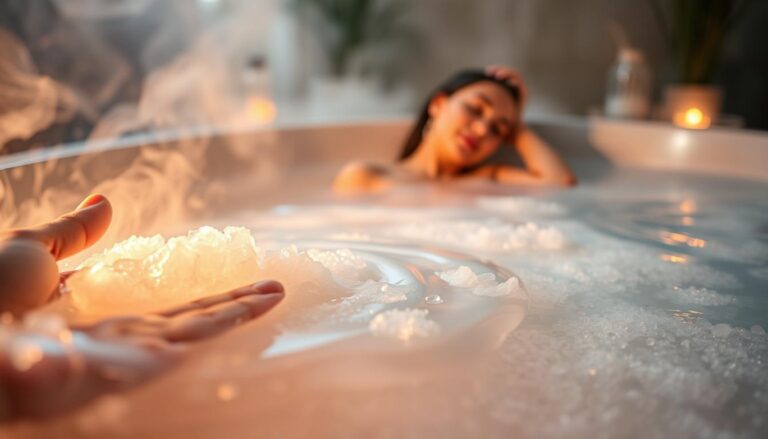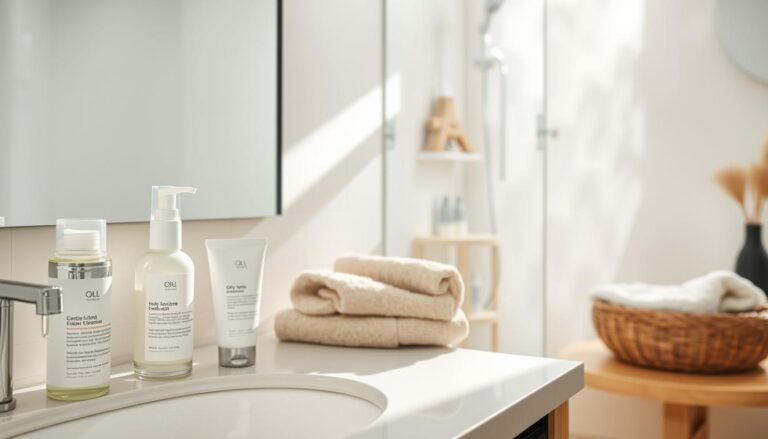At Glowskinhub.com, we believe beauty isn’t just a look—it’s a feeling
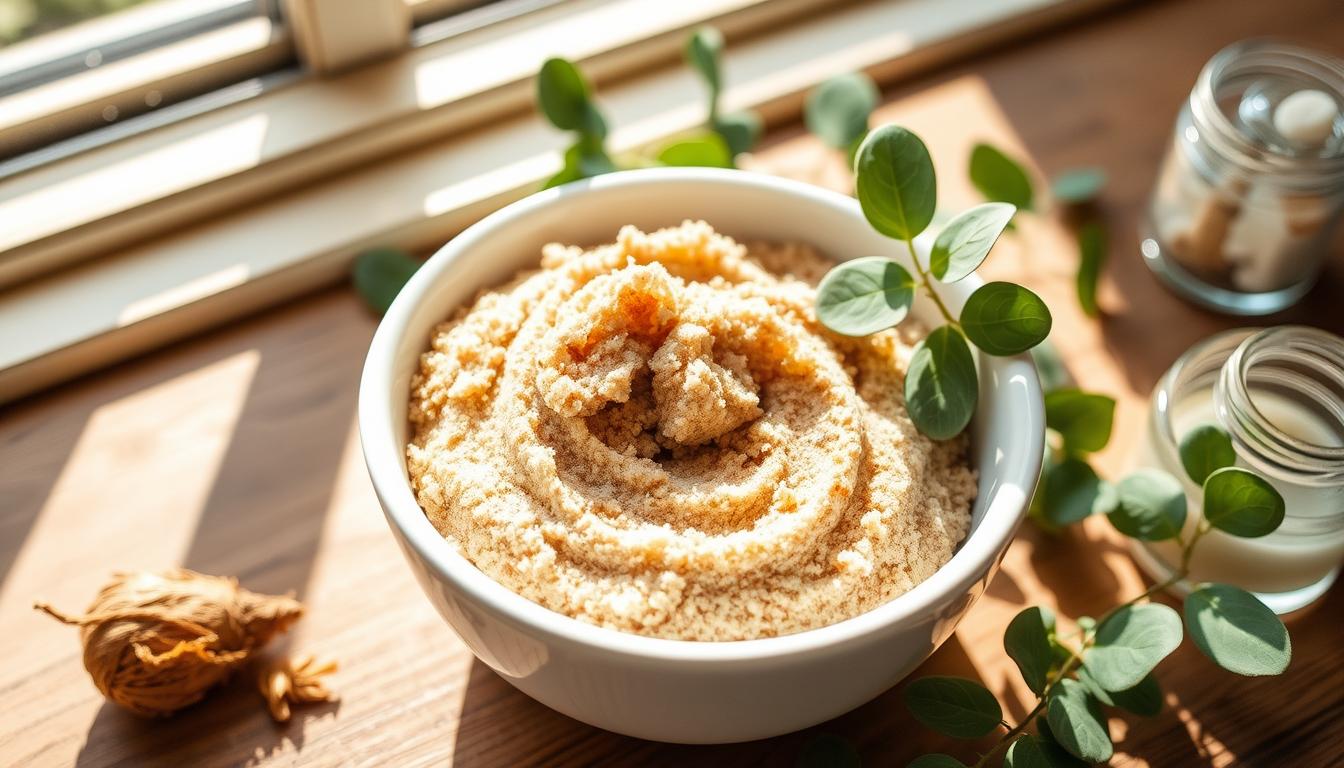
How to make your own exfoliating body scrub at home
Exfoliating is a crucial step in any skincare routine, helping to remove dead Skin cells and leave your Skin feeling smooth and refreshed. By creating a DIY body scrub, you can tailor the ingredients to your Skin type and preferences, avoiding harsh chemicals found in some commercial products.
Using natural ingredients like sugar, salt, and olive oil, you can create a nourishing exfoliating body scrub that not only exfoliates but also moisturises your Skin. This approach is not only cost-effective but also allows you to customise the scrub to suit your specific Skin needs.
Key Takeaways
- Creating a homemade body scrub allows for customisation to suit your Skin type.
- Natural ingredients like sugar and olive oil provide nourishment and moisturisation.
- Avoid harsh chemicals found in some commercial exfoliating products.
- DIY body scrubs are cost-effective and easy to make.
- Exfoliating regularly can improve Skin texture and appearance.
The Benefits of Homemade Body Scrubs
Making your own exfoliating body scrub can be a game-changer for your skincare routine. By opting for homemade body scrubs, you can enjoy several benefits that commercial products often can’t match.
Cost-Effectiveness Compared to Commercial Products
One of the significant advantages of homemade body scrubs is their cost-effectiveness. Most ingredients are readily available in your kitchen, reducing the need for expensive purchases. For instance, using sugar, salt, and coffee grounds as exfoliants can be significantly cheaper than buying commercial scrubs. This approach not only saves money but also allows you to create products tailored to your Skin type without breaking the bank.
Control Over Ingredients and Avoiding Harmful Chemicals
When you make your own body scrub, you have complete control over the ingredients. This is particularly beneficial for those with sensitive Skin or allergies, as you can avoid harsh chemicals commonly found in commercial products. By choosing natural ingredients, you can ensure that your scrub is free from potentially irritating substances, making it a safer choice for your Skin.
Customisation for Your Specific Skin Needs
Homemade body scrubs can be customised to suit your specific Skin needs. Whether you have oily Skin, dry Skin, or a combination of both, you can adjust the ingredients accordingly. For example, individuals with oily Skin can benefit from scrubs that include ingredients like clay, which helps to absorb excess oil. This level of customisation is often not possible with commercial products, making homemade scrubs a more effective solution for many Skin types.

Understanding Exfoliation and Your Skin Type
Understanding your Skin type and how exfoliation works is key to creating an effective skincare regimen. Exfoliation is the process of removing dead Skin cells from the surface of your Skin, which can help improve Skin texture and appearance.
How Exfoliation Works
Exfoliation works by gently removing the top layer of dead Skin cells, revealing smoother, brighter Skin. This process can be achieved through mechanical means, such as using a scrub, or chemical means, using alpha-hydroxy acids (AHAs) or beta-hydroxy acids (BHAs).
Identifying Your Skin Type
Identifying your Skin type is crucial for determining the best exfoliation method. Skin types generally fall into four categories: normal, dry, oily, and combination. Understanding your Skin type will help you choose the most suitable oily Skin products or routines.
Special Considerations for Oily Skin
Oily Skin requires special care when it comes to exfoliation. Regular exfoliation can help control oil production and reduce the appearance of pores.
Why Oily Skin Benefits from Regular Exfoliation
Regular exfoliation helps to unclog pores and reduce sebum buildup, which can lead to acne. Using the best products for oily Skin during exfoliation can enhance these benefits.
Exfoliation Frequency for Oily Skin
For oily Skin, it’s generally recommended to exfoliate 2-3 times a week. Over-exfoliating can lead to irritation, so it’s crucial to find a balance that works for your Skin as part of your oily Skin routine.
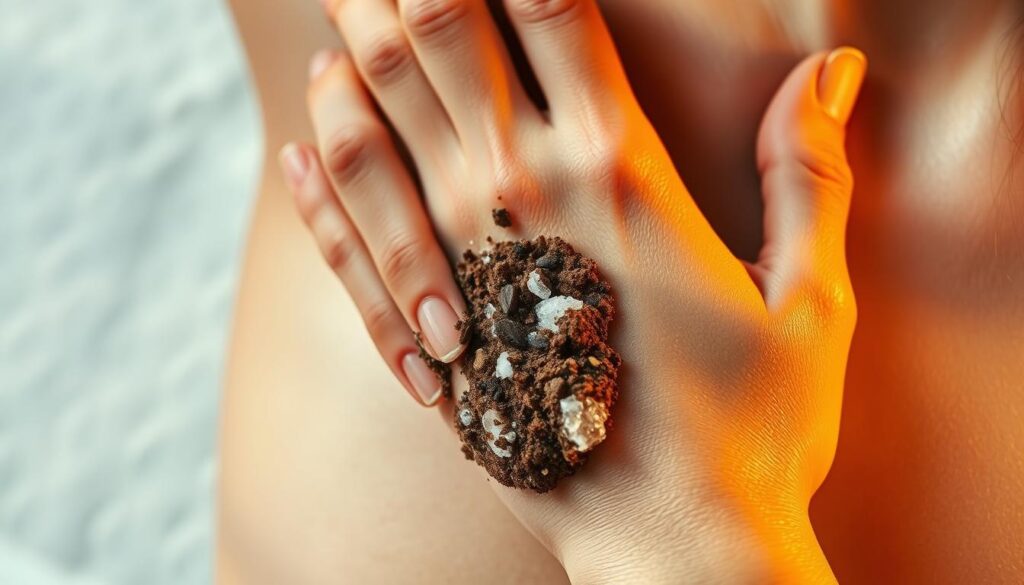
Essential Ingredients for Homemade Body Scrubs
To make an effective homemade body scrub, it’s crucial to understand the role of different ingredients. The right combination can help achieve smoother, healthier-looking Skin.
Base Exfoliants: Sugars, Salts, and Coffee Grounds
Base exfoliants are the primary ingredients that help remove dead Skin cells. Sugars, such as sugar cane and brown sugar, are gentle and suitable for sensitive Skin. Salts, like sea salt and Epsom salt, are more abrasive and often used for their detoxifying properties. Coffee grounds are another popular exfoliant, known for their ability to improve circulation and reduce the appearance of cellulite.
| Exfoliant | Skin Type | Benefits |
|---|---|---|
| Sugar | Sensitive | Gentle, moisturising |
| Salt | Normal to oily | Detoxifying, invigorating |
| Coffee grounds | Normal to dry | Improves circulation, reduces cellulite appearance |
Carrier Oils and Their Properties
Carrier oils are used to dilute essential oils and provide moisturising benefits. Popular carrier oils include coconut oil, sweet almond oil, and olive oil. Each has its unique properties, such as antibacterial, anti-inflammatory, or nourishing effects.

Natural Additives: Herbs, Essential Oils, and Clays
Natural additives can enhance the effectiveness of your homemade body scrub. Herbs like calendula and chamomile can soothe the Skin, while essential oils like lavender and tea tree oil provide additional benefits. Clays, such as kaolin and bentonite clay, can help detoxify and purify the Skin.
Ingredients Specifically Beneficial for Oily Skin
For oily Skin, ingredients like tea tree oil and lemon essential oil can help control oil production and reduce acne. Using a scrub with clay can also help absorb excess oil and purify the Skin, making it an effective oily Skin treatment.
Basic Equipment Needed for Making Body Scrubs
To make your own DIY body scrub, you’ll need a few simple tools and containers. Making a homemade body scrub is a straightforward process that requires minimal equipment, most of which you might already have in your kitchen.
Kitchen Tools and Storage Containers
The basic kitchen tools required include a mixing bowl, a spoon or spatula for mixing, and storage containers for keeping your scrub fresh. You can use airtight glass jars for storing your homemade scrubs, as they help maintain the freshness of the ingredients.
| Tool/Container | Purpose |
|---|---|
| Mixing Bowl | For combining ingredients |
| Spoon/Spatula | For mixing the scrub |
| Airtight Glass Jars | For storing the finished scrub |
Measuring and Mixing Essentials
For measuring, you’ll need measuring cups and spoons to ensure that your ingredients are accurately proportioned. A whisk or blender can be useful for mixing the ingredients thoroughly, especially if you’re using thicker oils or clays.

How to Make Your Own Exfoliating Body Scrub at Home
Creating your own exfoliating body scrub at home is a straightforward process that requires just a few simple ingredients. This not only allows you to control what goes onto your Skin but also ensures that you’re using products that are tailored to your specific Skin needs.

Step-by-Step Instructions for a Simple Sugar Scrub
To make a simple sugar scrub, you’ll need 1 cup of sugar, 1/2 cup of carrier oil (such as coconut or olive oil), and a few drops of your preferred essential oil for Fragrance. Begin by mixing the sugar and carrier oil in a bowl until you achieve a consistent texture. Add the essential oil and mix well. This scrub is perfect for most Skin types and can be adjusted according to your needs.
Proper Mixing Techniques
When mixing your scrub, it’s essential to achieve the right consistency. Start with a small amount of carrier oil and gradually add more until you reach your desired texture. Use a spoon or spatula to mix the ingredients thoroughly, ensuring there are no lumps.
Consistency Adjustments
The consistency of your scrub can be adjusted based on your preference. For a thicker scrub, use less carrier oil. For a smoother scrub, add more oil. It’s also worth noting that different carrier oils have different properties, so you may need to experiment to find the best skincare routine for oily Skin. For oily Skin, lighter oils like grapeseed can be particularly effective.
By following these simple steps, you can create an effective exfoliating body scrub that leaves your Skin feeling smooth and refreshed.
Specialised Scrub Recipes for Different Skin Types
Tailoring your body scrub to your specific Skin type can make a significant difference in achieving the best results. Different Skin types have unique needs, and using a scrub that’s formulated for your Skin can help address specific concerns such as dryness, oiliness, or sensitivity.
Gentle Scrubs for Sensitive Skin
For sensitive Skin, it’s essential to use gentle ingredients that won’t cause irritation. A scrub made with fine sugar, coconut oil, and chamomile can be very soothing. The anti-inflammatory properties of chamomile help calm the Skin, while coconut oil moisturises and nourishes.
Invigorating Scrubs for Normal Skin
Normal Skin can benefit from a scrub that’s invigorating and refreshing. A coffee grounds scrub with olive oil and a hint of citrus essential oil can be very effective. The caffeine in coffee grounds helps improve circulation, leaving the Skin feeling smooth and refreshed.
Balancing Scrubs for Oily Skin
Oily Skin requires a scrub that can help control oil production without drying out the Skin. Here are some recipes that can help:
Tea Tree and Lemon Clarifying Scrub
A scrub made with tea tree oil, lemon juice, and salt can help clarify and balance oily Skin. Tea tree oil has antibacterial properties that can help reduce acne, while lemon juice helps to brighten and even out Skin tone.
Clay and Witch Hazel Pore-Refining Scrub
Using clay and witch hazel in a scrub can help refine pores and reduce oiliness. The absorbent properties of clay help to draw out impurities, while witch hazel tightens the Skin and reduces the appearance of pores.
Oily Skin Moisturiser Recommendations Post-Scrub
Even oily Skin needs moisturising after exfoliating. Look for lightweight, oil-free moisturisers that won’t clog pores. Ingredients like hyaluronic acid and glycerin are excellent for locking in moisture without exacerbating oiliness.
| Skin Type | Recommended Ingredients | Benefits |
|---|---|---|
| Sensitive | Fine sugar, coconut oil, chamomile | Soothing, moisturising, anti-inflammatory |
| Normal | Coffee grounds, olive oil, citrus essential oil | Invigorating, improves circulation, refreshing |
| Oily | Tea tree oil, lemon juice, salt, clay, witch hazel | Clarifying, balancing, pore-refining, oil-controlling |
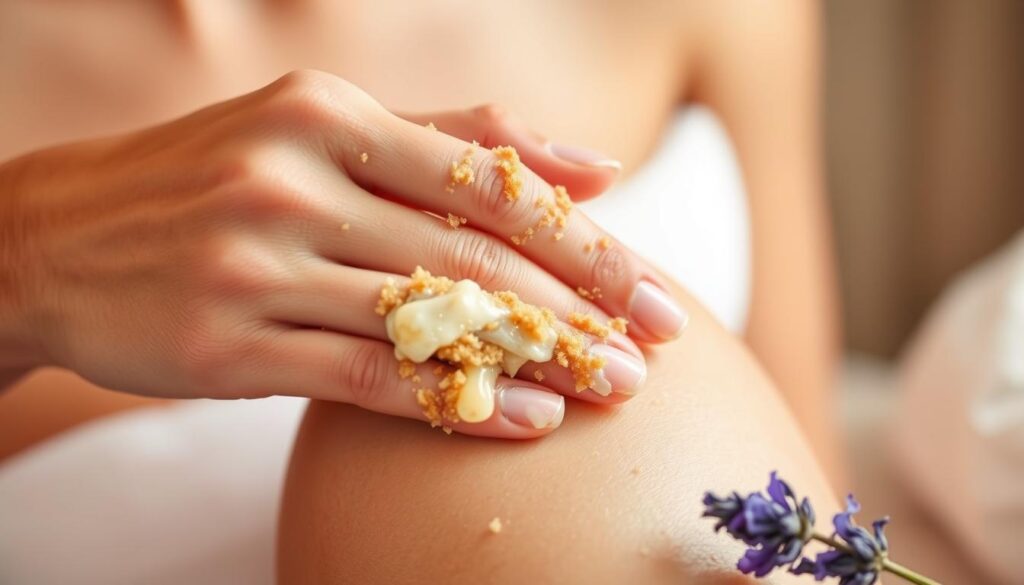
Targeted Body Scrub Recipes for Specific Concerns
For those seeking to address specific Skin concerns, targeted body scrub recipes can be a game-changer. Different Skin issues require tailored approaches, and body scrubs are no exception. By using the right ingredients, you can create scrubs that not only exfoliate but also nourish and protect your Skin.

Anti-Cellulite Coffee Scrub
Coffee grounds are a popular ingredient in anti-cellulite scrubs due to their ability to improve circulation and reduce the appearance of dimpled Skin. To make an anti-cellulite coffee scrub, mix coffee grounds with a carrier oil like coconut or olive oil, and add a few drops of cypress essential oil for its vasoconstrictive properties.
Brightening Lemon and Yoghurt Scrub
A brightening lemon and yoghurt scrub can help to even out Skin tone and leave your Skin feeling smooth and refreshed. Mix lemon juice with yoghurt, sugar, and a touch of honey for its moisturising properties. The citric acid in lemon juice gently exfoliates and brightens, while yoghurt soothes and hydrates the Skin.
Detoxifying Charcoal and Clay Scrub
For a detoxifying charcoal and clay scrub, combine activated charcoal with clay powder and a carrier oil. The charcoal and clay work together to draw out impurities and purify the Skin, leaving it feeling clean and refreshed.
Moisturising Honey and Oatmeal Scrub
A moisturising honey and oatmeal scrub is perfect for dry or sensitive Skin. Mix ground oatmeal with honey and a carrier oil to create a soothing and nourishing scrub. The oatmeal gently exfoliates, while honey locks in moisture, leaving your Skin feeling soft and supple.
Seasonal Body Scrub Variations
The key to maintaining healthy, glowing Skin lies in adjusting your body scrub according to the season. As the weather changes, so do our Skin’s needs, making it crucial to modify our exfoliating routines to keep our Skin balanced and nourished.
Refreshing Summer Scrubs
During summer, the Skin is exposed to more sun, sweat, and humidity. A refreshing body scrub can help remove dead Skin cells and keep the Skin cool. Incorporating ingredients like citrus fruits, mint, and cucumber can provide a cooling effect. For those with oily Skin, using a scrub with best products for oily Skin such as tea tree oil or salicylic acid can help control oil production.
Nourishing Winter Formulations
Winter can be harsh on the Skin, causing dryness and irritation. Nourishing body scrubs that include ingredients like shea butter, coconut oil, and sugar can help moisturise and protect the Skin. For oily Skin, it’s essential to find a balance between nourishment and non-comedogenic properties; an oily Skin moisturiser that is non-greasy can be particularly beneficial.
Transitional Recipes for Spring and Autumn
During spring and autumn, the Skin undergoes a transition from the extremes of winter and summer. Scrubs that contain natural additives like herbs and essential oils can help revitalise the Skin. For spring, consider a scrub with lemon and green tea, while for autumn, a scrub with cinnamon and apple cider vinegar can be invigorating.
By adjusting your body scrub recipes according to the seasons, you can ensure that your Skin remains healthy and radiant throughout the year. Key ingredients and formulations can be tailored to address specific seasonal Skin concerns.
Proper Application Techniques for Maximum Benefits
To get the most out of your homemade body scrub, it’s essential to apply it properly. This involves a few simple steps that can significantly enhance the effectiveness of your oily Skin treatment and overall oily Skin care tips.
Pre-Exfoliation Preparation
Before applying your body scrub, ensure your Skin is properly prepared. Start by wetting your Skin in the shower, then gently pat it dry with a towel to remove excess moisture. This step helps the scrub adhere evenly to your Skin.
Correct Scrubbing Methods for Different Body Parts
When applying the scrub, use circular motions to massage it into your Skin. Be gentle on sensitive areas and more vigorous on areas like elbows and heels. Pay special attention to areas prone to oily Skin, such as the back and chest.
| Body Part | Scrubbing Technique | Benefits |
|---|---|---|
| Elbows and Heels | Vigorous circular motions | Removes dead Skin cells effectively |
| Sensitive Areas | Gentle circular motions | Exfoliates without causing irritation |
| Oily Skin Areas | Moderate circular motions | Helps control oil production |
Post-Exfoliation Care
After scrubbing, rinse your Skin thoroughly with warm water, then moisturize to lock in hydration. This step is crucial for maintaining the health and smoothness of your Skin.
Special Application Tips for Oily Skin Areas
For areas with oily Skin, consider using a scrub that contains ingredients like clay or tea tree oil, known for their oil-controlling properties. Be gentle when scrubbing these areas to avoid irritating the Skin.
Storage and Shelf Life of Homemade Scrubs
Ensuring your homemade body scrubs remain effective over time involves proper storage techniques. Homemade body scrubs, being free from preservatives, have a limited shelf life compared to commercial products.
Proper Containers and Storage Conditions
Store your DIY body scrubs in airtight containers to prevent moisture and contaminants from entering. Keep them in a cool, dry place, away from direct sunlight. This helps in preserving the quality of the ingredients.
Signs of Spoilage and When to Discard
Check your homemade scrubs regularly for signs of spoilage, such as an off smell, slime, or mold. If you notice any of these, it’s best to discard the scrub to avoid any Skin issues. Typically, homemade body scrubs can last up to 3 months if stored properly.
Precautions and Best Practices for Oily Skin Treatment
To effectively manage oily Skin, it’s crucial to understand the best practices for exfoliation and how to avoid common pitfalls. Exfoliating is a vital part of any oily Skin routine, helping to remove dead Skin cells and unclog pores.
Areas to Avoid When Exfoliating
When exfoliating, it’s essential to avoid sensitive areas, such as the Skin around the eyes and any areas with active breakouts. Gentle exfoliation on other areas can help maintain a balanced oily Skin regimen.
Frequency Recommendations Based on Skin Type
For oily Skin, exfoliating 2-3 times a week is often recommended. However, this frequency can vary based on individual Skin types and needs. It’s about finding the right balance for your skincare for oily Skin.
Allergic Reactions and Patch Testing
Before using any new exfoliating product, even if it’s homemade, perform a patch test to check for any allergic reactions. This simple step can prevent unwanted Skin issues.
Conclusion
Creating your own exfoliating body scrub at home is a simple and cost-effective way to enhance your skincare routine, particularly for those with oily Skin. By understanding your Skin type and using natural ingredients, you can tailor your scrub to meet your specific needs.
Incorporating an exfoliating body scrub into your best skincare routine for oily Skin can help control oil production and reduce the appearance of pores. Regular exfoliation, combined with oily Skin care tips such as using the right cleanser and moisturizer, can lead to healthier and more balanced Skin.
With the variety of recipes available, you can experiment with different ingredients to find what works best for you. Whether you’re looking to brighten, nourish, or detoxify your Skin, making your own exfoliating body scrub is a great way to take control of your skincare.
Start exploring the world of homemade skincare and discover the benefits of exfoliating body scrubs for yourself. With a little creativity and some simple ingredients, you can achieve smoother, healthier-looking Skin.


